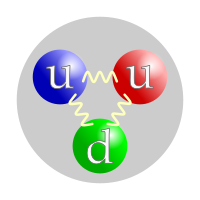
Photo from wikipedia
Motivated by the boost-invariant Glasma state in the initial stages in heavy-ion collisions, we perform classical-statistical simulations of SU(2) gauge theory in 2+1 dimensional space-time both with and without a… Click to show full abstract
Motivated by the boost-invariant Glasma state in the initial stages in heavy-ion collisions, we perform classical-statistical simulations of SU(2) gauge theory in 2+1 dimensional space-time both with and without a scalar field in the adjoint representation. We show that irrespective of the details of the initial condition, the far-from-equilibrium evolution of these highly occupied systems approaches a unique universal attractor at high momenta that is the same for the gauge and scalar sectors. We extract the scaling exponents and the form of the distribution function close to this non-thermal fixed point. We find that the dynamics are governed by an energy cascade to higher momenta with scaling exponents $\alpha = 3\beta$ and $\beta = -1/5$. We argue that these values can be obtained from parametric estimates within kinetic theory indicating the dominance of small momentum transfer in the scattering processes. We also extract the Debye mass non-perturbatively from a longitudinally polarized correlator and observe an IR enhancement of the scalar correlation function for low momenta below the Debye mass.
Journal Title: Physical Review D
Year Published: 2019
Link to full text (if available)
Share on Social Media: Sign Up to like & get
recommendations!